Kristine Hughes's Blog, page 150
May 6, 2011
Sir Lumley Skeffington
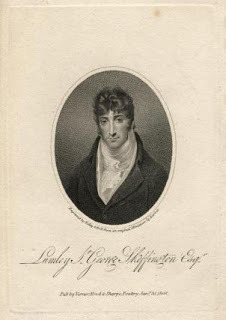 Sir Lumley St George Skeffington, 2nd Baronet
Sir Lumley St George Skeffington, 2nd Baronet
(23 March 1771 - 10 November 1850)
Copyright National Portrait Gallery
From the Letter Bag of Lady Elizabeth Stanhope
"Sir Lumley Skeffington, of Skeffington Hall, Leicestershire, was a celebrated votary of fashion. Descended from "Awly O'Farrell, King of Conereene," and from innumerable Kings and Princes of Ireland, his ancient lineage, as well as his pronounced dandyism, gave him a claim upon the attentions of society, which was further augmented by his literary pretensions. Nevertheless, he subsequently experienced a reverse of fortune, typical of the days in which he lived; and of his rise and fall John Stanhope gives a brief account.
"`Poor Skeffington,' he relates, `was the Dandy of the day, par excellence. Remarkable for his ugliness, his dress was so exaggerated as to render his lack of beauty the more marked. He was a very goodnatured man, and had nothing of the impertinence of manner of the fops who succeeded him. Moreover, he was a bel-esprit, writing epilogues and prologues, and was at one time the observed of all observers. I have seen him at an assembly literally surrounded by a group of admiring ladies.'"
"Skeffington, in short, in 1805, wrote a play entitled The Sleeping Beauty, which, produced at great expense at Drury Lane, gained for him much fame among his contemporaries and caused him for a time to be looked upon as a lion in the fashionable world. Enjoying to the full his reputation as a literary celebrity, he elected to ape certain mannerisms and eccentricities which he considered in keeping with this character. `He,' Gronow mentions, 'used to paint his face like a French toy. He dressed d la Robespierre and practised other follies, although the consummate old fop was a man of literary attainments, remarkable for his politeness and courtly manners, in fact, he was invited everywhere. You always knew of his approach by an avant courier (sic) of sweet smells, and as he advanced a little nearer, you might suppose yourself in the atmosphere of a barber's shop.'"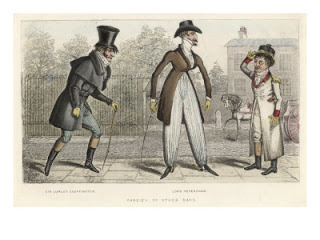 Sir Lumley Skeffington and Lord Petersham
Sir Lumley Skeffington and Lord Petersham
"Skeffington, after the publication of his play, was known by the nickname of `The Sleeping Beauty,' and a representation of him in that role John Stanhope describes as `the best caricature I ever saw.' Tall, thin, and a complete slave to his toilet, Sir Lumley not only indulged in an abnormal use of perfumes and cosmetics, but was incessantly to be seen combing his scented tresses by the aid of a hand mirror, till it was suggested that one of his Royal ancestors must have formed a mesalliance with the mermaid who most appropriately figured in his armorial bearings, similarly employed. The extreme slimness of his figure was accentuated by a coat which he made as famous as Lord Petersham did the garment called after his name; and Byron added to the fame of the beau by mentioning him in the satire English Bards and Scotch Reviewers.
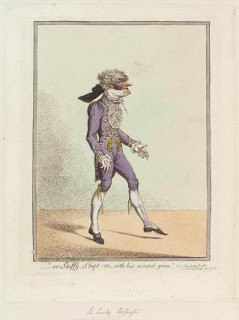 Sir Lumley St George Skeffington
Sir Lumley St George Skeffington
(' - "so Skiffy-skipt on, with his wonted grace" - ')
Copyright NPG
"Unfortunately, however, the harmless foibles of Sir Lumley were combined with an unbounded extravagance which finally involved the luckless dandy in a ruin as complete as it was pathetic. He disappeared from fashionable life to undergo a dreary imprisonment, and when he at last issued thence, the world which had showered blandishments upon him in his prosperity, would have no more of him. In vain did he dress exquisitely, enunciate witticisms and assume a gaiety of manner which he was far from feeling. The friends who had courted his society before his downfall now shunned his acquaintance, and a bon-mot uttered at his expense elicited the applause which his most happily-conceived jests failed to evoke. On some stranger pointing out Skeffington to Lord Alvanley, and inquiring who was that smart-looking individual, Alvanley responded with a wit more keen than kind— `It is a second edition of 'The Sleeping Beauty,' bound in calf, richly gilt and illustrated by many cuts.'
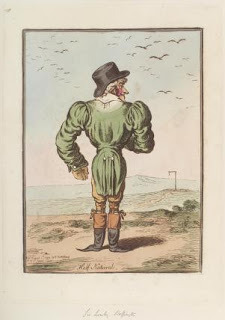 "Half Natural"
"Half Natural"
copyright NPG
"For long did the luckless beau continue, with a pathetic persistence, to haunt the scenes of his former triumph. At theatres, at picture auctions, in the Park, and in all fashionable thoroughfares, he was a familiar sight, still with the passing of years the butt of the contemporaries who had once fawned upon him, and, as they gradually diminished, the standard jest of a younger generation. With the flight of Time, the blackness of his false ringlets never varied, the brilliant rouge of his cheeks, or the strange costume which he had worn during the heyday of his existence, and to which he clung after it had been obsolete for half a century. And with each year his slim figure became yet thinner, his back more bent, and his spindle legs more bowed, till at length the man who had been born early in the reign of George III. witnessed the dawning of the year 1850; after which the quaint figure of the once-famous Sir Lumley Skeffington was seen no more."
But for some good news regarding Skeffington we turn now to Personal Reminiscences by Henry Fothergill Chorley, James Robinson Planché, Julian Charles Young (1874) -
"There was another habitui with whom I became acquainted at the same period; one of the last of that peculiar style of fop whose dress and manners were unsparingly caricatured in the print-shops, and became conventional on the stage. But with all his extravagance of attire, his various-colored under waistcoats, his rouged cheeks, and coal-black wig, with portentous toupie, poor old Sir Lumley Skeffington was a perfect gentleman, a most agreeable companion, and bore `the stings and arrows of outrageous fortune' with Spartan courage and Christian resignation. Though his fair-weather friends had deserted him, no complaint or reproach ever passed his lips. But once only, during the many years we were acquainted, did I hear him allude to the misery of his position. We were the only two guests at the dinner-table of a mutual friend, and Sir Lumley had been particularly lively and entertaining. Our host being called out of the room to speak to some one on business, I congratulated the old baronet on his excellent spirits. `Ah! my dear Mr. Planche', he replied, `it's all very well while I am in society; but I give you my honor, I should heartily rejoice if I felt certain that after leaving this house to-night I should be found dead on my own doorstep.' I shall never forget the deep but quiet pathos of these sad words. I am happy to add that he lived to inherit a small property, and ended his days in peace and comfort."
 Sir Lumley St George Skeffington, 2nd Baronet
Sir Lumley St George Skeffington, 2nd Baronet(23 March 1771 - 10 November 1850)
Copyright National Portrait Gallery
From the Letter Bag of Lady Elizabeth Stanhope
"Sir Lumley Skeffington, of Skeffington Hall, Leicestershire, was a celebrated votary of fashion. Descended from "Awly O'Farrell, King of Conereene," and from innumerable Kings and Princes of Ireland, his ancient lineage, as well as his pronounced dandyism, gave him a claim upon the attentions of society, which was further augmented by his literary pretensions. Nevertheless, he subsequently experienced a reverse of fortune, typical of the days in which he lived; and of his rise and fall John Stanhope gives a brief account.
"`Poor Skeffington,' he relates, `was the Dandy of the day, par excellence. Remarkable for his ugliness, his dress was so exaggerated as to render his lack of beauty the more marked. He was a very goodnatured man, and had nothing of the impertinence of manner of the fops who succeeded him. Moreover, he was a bel-esprit, writing epilogues and prologues, and was at one time the observed of all observers. I have seen him at an assembly literally surrounded by a group of admiring ladies.'"
"Skeffington, in short, in 1805, wrote a play entitled The Sleeping Beauty, which, produced at great expense at Drury Lane, gained for him much fame among his contemporaries and caused him for a time to be looked upon as a lion in the fashionable world. Enjoying to the full his reputation as a literary celebrity, he elected to ape certain mannerisms and eccentricities which he considered in keeping with this character. `He,' Gronow mentions, 'used to paint his face like a French toy. He dressed d la Robespierre and practised other follies, although the consummate old fop was a man of literary attainments, remarkable for his politeness and courtly manners, in fact, he was invited everywhere. You always knew of his approach by an avant courier (sic) of sweet smells, and as he advanced a little nearer, you might suppose yourself in the atmosphere of a barber's shop.'"
 Sir Lumley Skeffington and Lord Petersham
Sir Lumley Skeffington and Lord Petersham
"Skeffington, after the publication of his play, was known by the nickname of `The Sleeping Beauty,' and a representation of him in that role John Stanhope describes as `the best caricature I ever saw.' Tall, thin, and a complete slave to his toilet, Sir Lumley not only indulged in an abnormal use of perfumes and cosmetics, but was incessantly to be seen combing his scented tresses by the aid of a hand mirror, till it was suggested that one of his Royal ancestors must have formed a mesalliance with the mermaid who most appropriately figured in his armorial bearings, similarly employed. The extreme slimness of his figure was accentuated by a coat which he made as famous as Lord Petersham did the garment called after his name; and Byron added to the fame of the beau by mentioning him in the satire English Bards and Scotch Reviewers.
 Sir Lumley St George Skeffington
Sir Lumley St George Skeffington (' - "so Skiffy-skipt on, with his wonted grace" - ')
Copyright NPG
"Unfortunately, however, the harmless foibles of Sir Lumley were combined with an unbounded extravagance which finally involved the luckless dandy in a ruin as complete as it was pathetic. He disappeared from fashionable life to undergo a dreary imprisonment, and when he at last issued thence, the world which had showered blandishments upon him in his prosperity, would have no more of him. In vain did he dress exquisitely, enunciate witticisms and assume a gaiety of manner which he was far from feeling. The friends who had courted his society before his downfall now shunned his acquaintance, and a bon-mot uttered at his expense elicited the applause which his most happily-conceived jests failed to evoke. On some stranger pointing out Skeffington to Lord Alvanley, and inquiring who was that smart-looking individual, Alvanley responded with a wit more keen than kind— `It is a second edition of 'The Sleeping Beauty,' bound in calf, richly gilt and illustrated by many cuts.'
 "Half Natural"
"Half Natural"copyright NPG
"For long did the luckless beau continue, with a pathetic persistence, to haunt the scenes of his former triumph. At theatres, at picture auctions, in the Park, and in all fashionable thoroughfares, he was a familiar sight, still with the passing of years the butt of the contemporaries who had once fawned upon him, and, as they gradually diminished, the standard jest of a younger generation. With the flight of Time, the blackness of his false ringlets never varied, the brilliant rouge of his cheeks, or the strange costume which he had worn during the heyday of his existence, and to which he clung after it had been obsolete for half a century. And with each year his slim figure became yet thinner, his back more bent, and his spindle legs more bowed, till at length the man who had been born early in the reign of George III. witnessed the dawning of the year 1850; after which the quaint figure of the once-famous Sir Lumley Skeffington was seen no more."
But for some good news regarding Skeffington we turn now to Personal Reminiscences by Henry Fothergill Chorley, James Robinson Planché, Julian Charles Young (1874) -
"There was another habitui with whom I became acquainted at the same period; one of the last of that peculiar style of fop whose dress and manners were unsparingly caricatured in the print-shops, and became conventional on the stage. But with all his extravagance of attire, his various-colored under waistcoats, his rouged cheeks, and coal-black wig, with portentous toupie, poor old Sir Lumley Skeffington was a perfect gentleman, a most agreeable companion, and bore `the stings and arrows of outrageous fortune' with Spartan courage and Christian resignation. Though his fair-weather friends had deserted him, no complaint or reproach ever passed his lips. But once only, during the many years we were acquainted, did I hear him allude to the misery of his position. We were the only two guests at the dinner-table of a mutual friend, and Sir Lumley had been particularly lively and entertaining. Our host being called out of the room to speak to some one on business, I congratulated the old baronet on his excellent spirits. `Ah! my dear Mr. Planche', he replied, `it's all very well while I am in society; but I give you my honor, I should heartily rejoice if I felt certain that after leaving this house to-night I should be found dead on my own doorstep.' I shall never forget the deep but quiet pathos of these sad words. I am happy to add that he lived to inherit a small property, and ended his days in peace and comfort."
Published on May 06, 2011 00:52
May 5, 2011
Canaletto and His Rivals
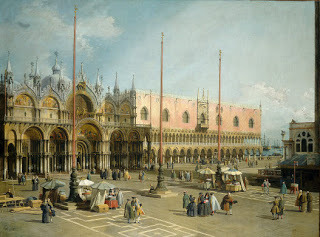
Victoria here. It seems like ages since I was in Washington D.C. with my friends Diane Gaston, Julie Halperson and Carol Stroud, but seeing the calendar page turn to May reminded me that I have not yet posted on our visit to the National Gallery to view the exhibition Venice: Canaletto and His Rivals. The exhibition will close on May 30, 2011, so you have a limited time to enjoy the show, as we four did last March. Above is The Piazza San Marco and the Piazzetta, Looking Southeast, c. 1743, from the National Gallery's permanent collection, gift of Mrs. Barbara Hutton.
For more information on the exhibition and the National Gallery's collections, click here.
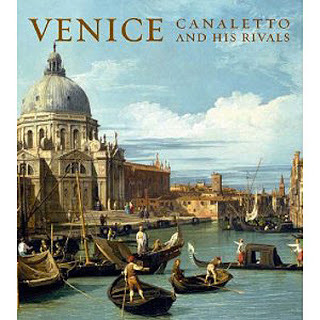 The CatalogueThe exhibition was organized by Washington's National Gallery and the UK National Gallery in London, where it was seen October 2010-January, 2011. Here is a link to the UK's description of the exhibition.
The CatalogueThe exhibition was organized by Washington's National Gallery and the UK National Gallery in London, where it was seen October 2010-January, 2011. Here is a link to the UK's description of the exhibition.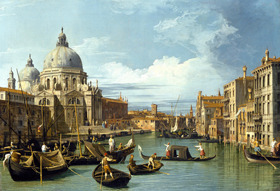
Canaletto, The Entrance to the Grand Canal, looking West, with Santa Maria della Salute, about 1729
© The Museum of Fine Arts, Houston. The Robert Lee Blaffer Memorial Collection, gift of Sarah Campbell Blaffer
In the 18th Century, the city of Venice was a magnet for travelers, a city that fascinates even today with its unique setting, magnificent architecture and amazing cultural assets. Many of these travelers were British aristocrats and students on their Grand Tour, an essential part of a gentleman's education. Among the mementos of their travels, many chose to buy views of Venice to be shipped home for the admiration of friends and associates.
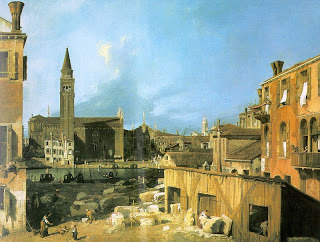 The Stonemason's Yard, National Gallery, LondonWorks by Canaletto were especially prized by these travelers, though a number of painters also created majestic cityscapes, both of the principal government buildings and festivals and of the ordinary people going about their daily tasks. The paintings usually had a panoramic sweep of city views combined with very detailed portraits of individuals and animals. One huge canvas had hundreds of gondolas, other boats, people, birds and fowl, and, at a very close look, a dog relieving himself against a building. We examined many of the pictures for all these details and could have spent many more hours before we exhausted the possibilities: a woman peeping out of a window, a sailor tipping his hat, a lady holding tight to her skirts in the breeze.
The Stonemason's Yard, National Gallery, LondonWorks by Canaletto were especially prized by these travelers, though a number of painters also created majestic cityscapes, both of the principal government buildings and festivals and of the ordinary people going about their daily tasks. The paintings usually had a panoramic sweep of city views combined with very detailed portraits of individuals and animals. One huge canvas had hundreds of gondolas, other boats, people, birds and fowl, and, at a very close look, a dog relieving himself against a building. We examined many of the pictures for all these details and could have spent many more hours before we exhausted the possibilities: a woman peeping out of a window, a sailor tipping his hat, a lady holding tight to her skirts in the breeze.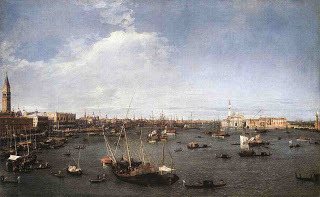
Canaletto, The Bacino di San Marco, about 1738-9, © Museum of Fine Arts, Boston. Abbott Lawrence Fund, Seth K. Sweetser Fund, and Charles Edward French Fund
The description of the exhibition states, "Venice inspired a school of competitive view painters whose achievements are among the most brilliant in 18th-century art. The exhibition celebrates the rich variety of these Venetian views, known as vedute, through some 20 masterworks by Canaletto and more than 30 by his rivals, including Michele Marieschi, Francesco Guardi, and Bernardo Bellotto. Responding to an art market fueled largely by the Grand Tour, these gifted painters depicted the famous monuments and vistas of Venice in different moods and seasons."
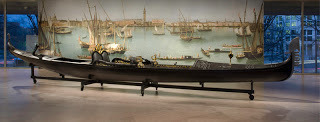 Above, the Moran gondola at the entrance to the exhibition. Photo by Rob Shelley © 2011 National Gallery of Art, Washington
Above, the Moran gondola at the entrance to the exhibition. Photo by Rob Shelley © 2011 National Gallery of Art, Washington
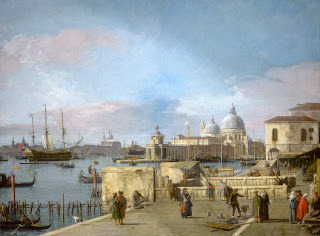 Entrance to the Grand Canal from the Molo, Venice, 1742-44
Entrance to the Grand Canal from the Molo, Venice, 1742-44National Gallery of Art, Washington
Gift of Mrs. Barbara Hutton
 Giovanni Antonio Canal (1697–1768) was known as Canaletto, was the most famous of these Venetian vedute painters. The wealthy British merchant in Venice, Joseph Smith, introduced Canaletto and his work to many British aristocrats as early as the 1720's. In 1746, Canaletto brought his skills to Britain, where he painted many famous London landscapes and buildings.
Giovanni Antonio Canal (1697–1768) was known as Canaletto, was the most famous of these Venetian vedute painters. The wealthy British merchant in Venice, Joseph Smith, introduced Canaletto and his work to many British aristocrats as early as the 1720's. In 1746, Canaletto brought his skills to Britain, where he painted many famous London landscapes and buildings.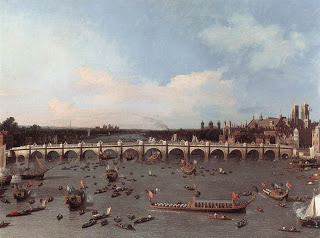
The 1746 view of Westminster Bridge hangs in the Yale Center for British Art
Canaletto returned to Venice in 1755, after painting in London and as far afield as Warwick Castle.
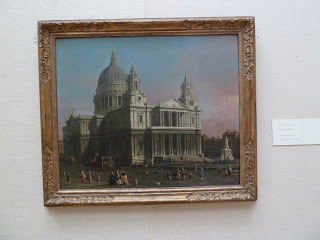 Above is Canaletto's portrayal of London's St Paul's Cathedral, hanging in the Yale Center for British Art.
Above is Canaletto's portrayal of London's St Paul's Cathedral, hanging in the Yale Center for British Art.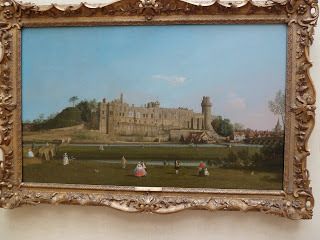
Above, Warwick Castle, painted for Lord Brooke (later Earl of Warwick) in 1748-49, also at the YCBA.
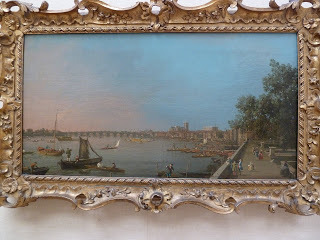 Canaletto, The Thames, from the Terrace of Somerset House, Looking Toward Westminster, c.1750
Canaletto, The Thames, from the Terrace of Somerset House, Looking Toward Westminster, c.1750also Paul Mellon Collection, Yale Center for British ArtThese last four paintings from the British stay of Canaletto are not part of the National Gallery exhibition, but fit well with the theme of this blog nevertheless.
To return to the exhibition Canaletto and His Rivals, we conclude with this view of the Rialto Bridge by Francesco Guardi (1712-1793), perhaps the last of the Venetian vedute painters to achieve lasting renown.
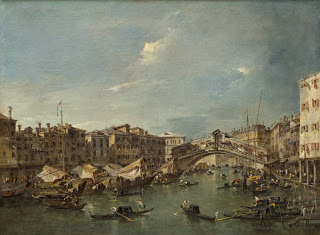
Francesco Guardi, Grand Canal with the Rialto Bridge, Venice, probably c. 1780
National Gallery of Art, Widener Collection
If you can get to Washington D.C. this month, be sure to visit this excellent exhibition.
Published on May 05, 2011 02:00
May 4, 2011
The Wellington Connection: Traffic Court
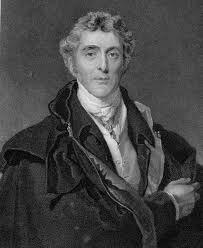
From The Life of the Duke of Wellington by Joachim Hayward Stocqueler, Volume 2 1853
The Duke of Wellington attended on Saturday (4th May, 1845) at the Marlborough Street Police Court, for the purpose of preferring a charge of furious driving, whereby his life was endangered, against Henry Woods, driver of one of the carriers' carts. To prevent inconvenience to his Grace from the crowd which his appearance would attract to this court, the summons was so arranged as to take precedence of the night charges. At half-past eleven o'clock his Grace, accompanied by Lord Charles Fitzroy Somerset and Mr. Mayne, entered the court. His Grace having been sworn, said—I was walking, on Tuesday last, between two and three o'clock, in Park Lane, on the left-hand side, going out of Piccadilly, and when near the Duchess of Gloucester's house, a very heavy four-wheeled cart passed me. I endeavoured to cross the lane, to get to the pavement on the other side, under the protection of this heavy cart; I got as far as the right-hand wheel of the cart, keeping the cart at my left hand, when I found myself struck on the shoulder, and knocked forward. It was a severe blow, and I found it had been given by another cart, the driver of which did not attempt to give me warning by calling out, until he had struck me. I did not fall; if I had, I must have been under the wheels of both carts. Now, I have no further complaint to make against the man at the bar who drove the cart, than that he was going at such a monstrous pace that he had no control over his horse; indeed, he came along so fast, that he got the whole length of Park Lane without my having perceived him; and the pace he was going at was such, that it was impossible he could stop his horse. This is my complaint; and I bring it forward on public grounds, because I think it is not right that carriages should go along in the public streets at this great rate. The cart by which I was struck was a heavy, tilted cart; the driver was under the tilt. My groom was behind with my horses, and I called him and desired him to follow the cart. My groom trotted as hard as he could, but was unable to overtake the cart until he got as far as South Strand. This will prove the rapid pace at which the driver of the cart was going.
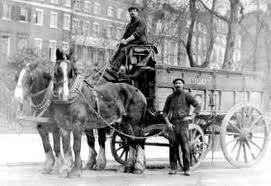 copyright The Canal Museum
copyright The Canal MuseumThe defendant said he was truly sorry at what had occurred, but he declared the whole circumstance was accidental. He saw a gentleman about to cross the road, and he called out to warn him; but be was not aware that he had touched any one. He was not going at very great speed, for his horse was an old one, and could not accomplish more than seven miles an hour; and at the time when he passed his Grace, he was going up hill. His attention was directed to the vehicles in the carriage-road, and this prevented his noticing what was doing on the foot-path.
Mr. Hardwick: Had you kept your eyes directed as you ought, not only to avoid carriages but foot passengers, the circumstance would not have occurred. The reason you have given for not seeing his Grace is no excuse for your conduct.
The Duke of Wellington: There was plenty of room to have passed, without running against me.
Mr. Hall, No. 12, Park Lane, said he saw his Grace attempting to cross the lane at the time that a carrier's cart, which was going at the rate of seven or eight miles an hour, was coming down the lane. Thinking, from the way the man was driving, that his Grace would be knocked down, he ran to the door, and saw the cart strike his Grace on the shoulder. Had his Grace but turned round sharply, the cart must have been over his feet. The pace the man was driving at was not more than seven miles an hour. He was driving negligently rather than furiously.
Mr. Hardwick: Had he kept a proper look-out, he must have seen his Grace?
Witness: Certainly. He was going up hill, and could have stopped the horse easier than if he was going down hill.
Mr. Hardwick: Did you hear the man call out? Witness: No, I did not.
In defence, the man repeated that he was exceedingly sorry for what had occurred.
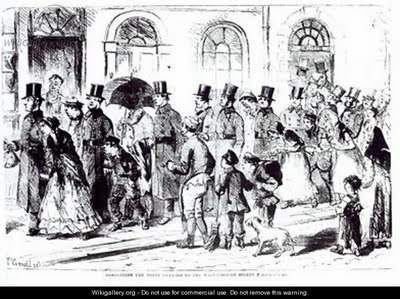 Conducting the Night Charges to the Marlborough Street Police Court
Conducting the Night Charges to the Marlborough Street Police Court copyright wikigallery
Mr. Hardwick: It appears from the evidence that you were driving, if not at a furious, still at a rapid rate; but as you were going up hill at the time, had you used the ordinary precautions in driving along the public street, and if you had proper command over your horse, this accident could not have occurred. A witness has described your careless mode of driving at the time, by saying you were neither looking to the right hand nor to the left; and the whole evidence goes to prove that your mode of driving was reckless and careless, exhibiting a perfect indifference to the life and limbs of foot-passengers. This case I shall deal with as a case of assault. You have committed several serious offences: first, furious driving; next, endangering life and limb; and, lastly, committing an assault, for running against the person and striking that person with the cart, is as much an assault as if the blow were given by hand. For the assault, which is clearly proved, you will pay a fine of 4l. or one month's imprisonment.
The defendant was then locked up.
Published on May 04, 2011 00:15
May 3, 2011
A Fatal Game of Tennis at Woburn Abbey
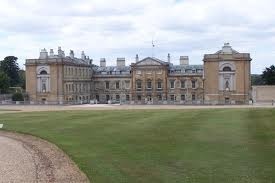 Woburn AbbeyFrom a letter written by Lady Holland to Mrs. Creevey [in Brussels]
Woburn AbbeyFrom a letter written by Lady Holland to Mrs. Creevey [in Brussels]
"Holland House, 1st Jany., 1816.
". . . According to the song, 'London is out of town;' the country houses are overflowing. The love of tennis is come so strongly upon Lord Holland that he has persuaded me rather reluctantly to go once more to Woburn for 3 or 4 days, in order that he may play a few setts. The plea which makes me yield is that I believe exercise keeps off the gout."
The Sporting Magazine for February 1795 gives us the following description of the Woburn tennis courts - "THE Tennis Court and Riding House (with apartments between to dress in) forms a building 266 feet 8 inches long, and 49 feet 6 inches wide, the whole front of which is stone: The roof is a flat one, and covered with a composition of tar, chalk, tec, instead of lead. There are flues run along the walls, and under the pavement of the Tennis Court, to keep off the damps."
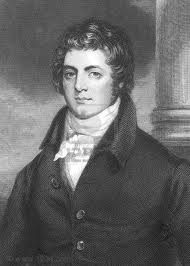 Francis Russell, 5th Duke of Bedford
Francis Russell, 5th Duke of Bedford
It was Francis Russell, 5th Duke of Bedford who improved Woburn Abbey, adding a Riding School and the Tennis Court, which would later quite literally be the death of him. It was while playing a game of tennis that the accident occurred which eventually proved fatal. He was struck by a ball; a lingering illness ensued, and he died on the 2nd March 1802.
The editor of Horace Walpole: Lord Orford's Letters to the Countess of Ossory, transcribes from the memoranda of Lord Ossory the following account of the death of Francis, fifth Duke of Bedford in 1802:— 'On February 27th 1802, I went over to Woburn, hearing of the Duke of Bedford's dangerous illness. There I found Dr. Kerr. .... The progress of the disease was not favourable, and the symptoms were very bad on Monday morning, till twelve; from that time till five or six, hopes began to revive; then they all vanished, and he was given over, and on Monday morning, March the 2d, about half-past eleven, he expired in a manner in Lord John's arms.
'Thus died Francis, Duke of Bedford, with a sort of similarity of fate to his father, both of whom I loved with much affection and attachment."
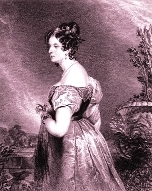
As lamentable as Francis's death was, it almost had dire consequences for the beautiful Lady Georgina Gordon, who had been engaged to him. Her mother, the Duchess of Gordon, was not going to let the Dukedom of Bedford escape her, and after Lady Georgina had left off her mourning for her betrothed, she became engaged to his brother and successor, John, sixth Duke of Bedford, to whom she was married a year later. She went on to have ten children.
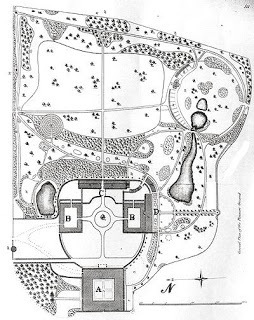 1816 Plan of Woburn Abbey - Wikipedia
1816 Plan of Woburn Abbey - Wikipedia
But back to tennis . . . From Wikipedia - A plan of the house and "pleasure ground" at Woburn from Hortus Gramineus Woburnensis (1816), a book about horticultural experiments conducted at Woburn. The top is east. A: The house. The whole of the top (east) wing and the eastern end of the north and south wings have been demolished. B: Stable/service blocks. These survive and one now houses the Woburn Antiques Centre. C: The riding school and the real tennis court, which have been demolished. D: The long rectangle at the right of the southern service block is the sculpture gallery, which survives In 1816 the main entrance was on the eastern side of the house, and was reached via a grand arch between the riding school and real tennis court. After the demolition the West Hall in the centre of the West Front became the main entrance once again.
In his Arboretun et Fruticetum Britannicum: or, The Trees and Shrubs of England, Volume 2 (1838), John Claudius Loudon describes the grounds at Woburn and tells us that there is "a passage under the Cape heathery, which forms a portion of a covered way, leading from the mansion to the different objects of interest adjoining it; such as the green-house, sculpture gallery, tennis-court, Chinese dairy, plant-stoves and palm-house now erecting, and finally to the pleasureground, including the aviary, arboretum, salictum, grass-garden, American garden, etc." From Tennis by John Moyer Heathcote 1890, "In our own country the game was beginning to lose its popular character, although still played by the higher classes of society. Many old courts were abandoned or destroyed, and we hear of the construction of three only in the latter half of the century: the Duke of Richmond's at Goodwood, the Duke of Bedford's at Woburn, and the court in Tennis-court Road, Cambridge, erected in 1734, recently pulled down and replaced by the new buildings of Pembroke College.
"There is, however, no probability of the last age of this eventful history passing into mere oblivion, for the nineteenth century has witnessed a renewed and constantly increasing enthusiasm for Tennis, shown by the number of courts built by public and private enterprise, on improved lines, and equipped with modern requirements, and by the interest taken in all important matches."
Whilst tennis is still played in England, alas, the courts at Worburn have, indeed, passed into oblivion. During the First World War parts of the Abbey, the riding school and indoor tennis court (now demolished), were converted into a temporary ward for wounded soldiers; some 2,000 patients passed through the Abbey Hospital.
 Woburn AbbeyFrom a letter written by Lady Holland to Mrs. Creevey [in Brussels]
Woburn AbbeyFrom a letter written by Lady Holland to Mrs. Creevey [in Brussels] "Holland House, 1st Jany., 1816.
". . . According to the song, 'London is out of town;' the country houses are overflowing. The love of tennis is come so strongly upon Lord Holland that he has persuaded me rather reluctantly to go once more to Woburn for 3 or 4 days, in order that he may play a few setts. The plea which makes me yield is that I believe exercise keeps off the gout."
The Sporting Magazine for February 1795 gives us the following description of the Woburn tennis courts - "THE Tennis Court and Riding House (with apartments between to dress in) forms a building 266 feet 8 inches long, and 49 feet 6 inches wide, the whole front of which is stone: The roof is a flat one, and covered with a composition of tar, chalk, tec, instead of lead. There are flues run along the walls, and under the pavement of the Tennis Court, to keep off the damps."
 Francis Russell, 5th Duke of Bedford
Francis Russell, 5th Duke of Bedford It was Francis Russell, 5th Duke of Bedford who improved Woburn Abbey, adding a Riding School and the Tennis Court, which would later quite literally be the death of him. It was while playing a game of tennis that the accident occurred which eventually proved fatal. He was struck by a ball; a lingering illness ensued, and he died on the 2nd March 1802.
The editor of Horace Walpole: Lord Orford's Letters to the Countess of Ossory, transcribes from the memoranda of Lord Ossory the following account of the death of Francis, fifth Duke of Bedford in 1802:— 'On February 27th 1802, I went over to Woburn, hearing of the Duke of Bedford's dangerous illness. There I found Dr. Kerr. .... The progress of the disease was not favourable, and the symptoms were very bad on Monday morning, till twelve; from that time till five or six, hopes began to revive; then they all vanished, and he was given over, and on Monday morning, March the 2d, about half-past eleven, he expired in a manner in Lord John's arms.
'Thus died Francis, Duke of Bedford, with a sort of similarity of fate to his father, both of whom I loved with much affection and attachment."

As lamentable as Francis's death was, it almost had dire consequences for the beautiful Lady Georgina Gordon, who had been engaged to him. Her mother, the Duchess of Gordon, was not going to let the Dukedom of Bedford escape her, and after Lady Georgina had left off her mourning for her betrothed, she became engaged to his brother and successor, John, sixth Duke of Bedford, to whom she was married a year later. She went on to have ten children.
 1816 Plan of Woburn Abbey - Wikipedia
1816 Plan of Woburn Abbey - Wikipedia But back to tennis . . . From Wikipedia - A plan of the house and "pleasure ground" at Woburn from Hortus Gramineus Woburnensis (1816), a book about horticultural experiments conducted at Woburn. The top is east. A: The house. The whole of the top (east) wing and the eastern end of the north and south wings have been demolished. B: Stable/service blocks. These survive and one now houses the Woburn Antiques Centre. C: The riding school and the real tennis court, which have been demolished. D: The long rectangle at the right of the southern service block is the sculpture gallery, which survives In 1816 the main entrance was on the eastern side of the house, and was reached via a grand arch between the riding school and real tennis court. After the demolition the West Hall in the centre of the West Front became the main entrance once again.
In his Arboretun et Fruticetum Britannicum: or, The Trees and Shrubs of England, Volume 2 (1838), John Claudius Loudon describes the grounds at Woburn and tells us that there is "a passage under the Cape heathery, which forms a portion of a covered way, leading from the mansion to the different objects of interest adjoining it; such as the green-house, sculpture gallery, tennis-court, Chinese dairy, plant-stoves and palm-house now erecting, and finally to the pleasureground, including the aviary, arboretum, salictum, grass-garden, American garden, etc." From Tennis by John Moyer Heathcote 1890, "In our own country the game was beginning to lose its popular character, although still played by the higher classes of society. Many old courts were abandoned or destroyed, and we hear of the construction of three only in the latter half of the century: the Duke of Richmond's at Goodwood, the Duke of Bedford's at Woburn, and the court in Tennis-court Road, Cambridge, erected in 1734, recently pulled down and replaced by the new buildings of Pembroke College.
"There is, however, no probability of the last age of this eventful history passing into mere oblivion, for the nineteenth century has witnessed a renewed and constantly increasing enthusiasm for Tennis, shown by the number of courts built by public and private enterprise, on improved lines, and equipped with modern requirements, and by the interest taken in all important matches."
Whilst tennis is still played in England, alas, the courts at Worburn have, indeed, passed into oblivion. During the First World War parts of the Abbey, the riding school and indoor tennis court (now demolished), were converted into a temporary ward for wounded soldiers; some 2,000 patients passed through the Abbey Hospital.
Published on May 03, 2011 00:08
May 2, 2011
Chicago Janeites Hold a Spring Gala
Three entertaining and informative presentations filled Saturday's meeting of the Greater Chicago Region of the Jane Austen Society of North America - "Staging Sensibility: Jane Austen and the Performing Arts." Along with many conversations centering on the Royal Wedding, members were fascinated by talks by Dr. Gillian Dow and Dr. Erin Smith, as well as an appearance by Jane Austen herself, in the person of Debra Ann Miller, all celebrating the 200th anniversary of Jane's Austen's first novel, Sense and Sensibility (1811).
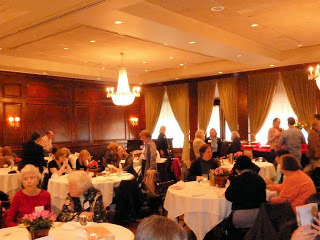
Maggiano's delicious continental breakfast and sumptuous luncheon made us feel like we were attending the royal wedding celebrations.
 Dr. Gillian Dow (l), of Chawton House Library and Southampton University; Regional Coordinator for GCR, Jeffrey Nigro; and Dr. Erin Smith of Western Governors University.
Dr. Gillian Dow (l), of Chawton House Library and Southampton University; Regional Coordinator for GCR, Jeffrey Nigro; and Dr. Erin Smith of Western Governors University.
Dr. Gillian Dow is a Lecturer at Chawton House Library in England and at the University of Southampton School of Humanities where she specializes in the literature of the 18th c, particularly French literature in Britain 1780-1830, cross-channel migration of ideas. Her topic for the morning was fascinating. "An Excess of Sensibility (for which we were always remarkable): Jane Austen, Marianne, and the French Tradition."
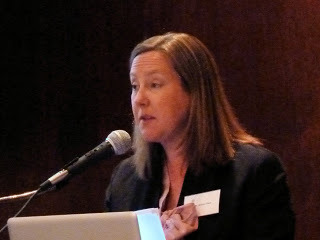
Addressing the theme of female hysteria in literature, she began by discussing Jane Austen's Love and Freindship, from her juvenilia, in which Laura, writing to Marianne (advice to her friend's daughter), relates her hyper-sensibility, alternately swooning and fainting at every turn of the plot. It is the kind of parody of exaggerated characters and overblown plots that the clever and witty young Jane Austen wrote for the amusement of her family. The female hysteric was a very familiar character in fiction of the time in Britain and on the continent. Dr. Dow introduced us to the novels of Pierre de Marivaux, a popular French author of the 18th c, whose novel La Vie de Marianne was popular in England in the early years of the 18th c, and was considered to be an influence on Fielding, Richardson and Fanny Burney, among others.
Dr. Dow related the enlightening story of the French translation of Austen's Sense and Sensibility by French novelist Isabelle Montolieu (1751-1832). From the letters of Austen sister-in-law Eliza de Feuillide. we know that Jane Austen read Montolieu's novel entitled Caroline de Lichtfield (1780's), but Austen probably never knew of the translation. Dr. Dow compared passages of the novel in Austen's original English to the corresponding translated French passages. Montolieu certainly added dramatically to the passages describing Marianne's emotional behavior, to a comical extent in the view of most of the audience. Or did that surprised laughter reflect dismay at the transformation of our Jane's sacred text?
Dr. Dow discussed Jane Austen's attitude toward sensbility, in which she differentiates between sensibility that is real and pure, as in Marianne Dashwood, and the phony and overly emotional sentimentality of other characters, such as the Steele sisters. The same kind of contrast, she said, could be found in Austen's portraits of Colonel Brandon and Willoughby, the former being an honorable man of feeling, complex and well-rounded, the latter showing the wrong side of sensibility, i.e. impulsive and ill-considered behavior reflecting shallowness and sham sincerity.
Everyone was buzzing about the amazing French translation and surprise that it, not the original English text, was sometimes used as the basis for translation of Sense and Sensibility into other European languages for many years. What, we wondered, would we have thought of Jane Austen if this exaggerated and hysterical version was our first introduction to her work?
 Dr. Erin Smith and Elisabeth Lenckos of the University of Chicago, Program Director for JASNA GCR.
Dr. Erin Smith and Elisabeth Lenckos of the University of Chicago, Program Director for JASNA GCR.
"Jane Austen and Ballet: Dances of Hysteria in Sense and Sensibility and Giselle" was Dr. Smith's topic. Her research into the theatrical ballets of the late 18th c. and up to the 1840's when Giselle was created lead her to believe that the romantic sensibilities of the period grew out of shared themes. Common to many balletic structures are young women on the brink of marriage, a moment of many dramatic possibilities, including alteration into a story of a female scorned and abandoned. Ballet was particularly well suited to portraying the "restless pain of mind and body" of the hysterical woman who goes "mad for love." In fact, Dr. Smith pointed out, these are almost the very words Jane Austen uses as Col. Brandon describes the fate of Eliza I.
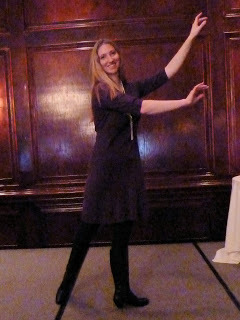 Dr. Smith demonstrates some of the most characteristic movements and gestures of 18th c. ballet.
Dr. Smith demonstrates some of the most characteristic movements and gestures of 18th c. ballet.
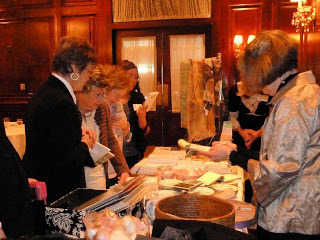 Before, after and during luncheon we shopped at the Emporium -- beautiful shawls, fashion prints, jewelry and hats were extremely tempting.
Before, after and during luncheon we shopped at the Emporium -- beautiful shawls, fashion prints, jewelry and hats were extremely tempting.
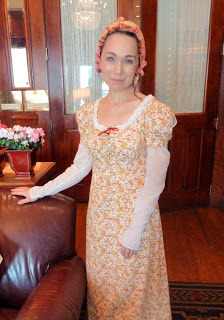 Miss Jane Austen herself graced our meeting -- in the person of actor Debra Ann Miller, who presented a charming account of Miss Austen's life, mainly in her own words.
Miss Jane Austen herself graced our meeting -- in the person of actor Debra Ann Miller, who presented a charming account of Miss Austen's life, mainly in her own words.
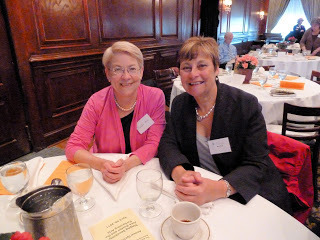 Among the honored guests were Marsha Huff, previous past-president of JASNA (l) and Karen Dow, proud mother of Dr. Gillian Dow, visiting from Yorkshire, on her very first trip to Chicago.
Among the honored guests were Marsha Huff, previous past-president of JASNA (l) and Karen Dow, proud mother of Dr. Gillian Dow, visiting from Yorkshire, on her very first trip to Chicago.
 Mother and daughter, Karen and Gillian, enjoying the afternoon and looking forward to a return visit to the Art Institute of Chicago to see the famous Thorne Rooms, miniatures which reproduce iconic rooms from history, especially British palaces. For a look yourself, click here.
Mother and daughter, Karen and Gillian, enjoying the afternoon and looking forward to a return visit to the Art Institute of Chicago to see the famous Thorne Rooms, miniatures which reproduce iconic rooms from history, especially British palaces. For a look yourself, click here.
Thanks to everyone at JASNA GCA for a scintillating and thought-provoking day.

Maggiano's delicious continental breakfast and sumptuous luncheon made us feel like we were attending the royal wedding celebrations.
 Dr. Gillian Dow (l), of Chawton House Library and Southampton University; Regional Coordinator for GCR, Jeffrey Nigro; and Dr. Erin Smith of Western Governors University.
Dr. Gillian Dow (l), of Chawton House Library and Southampton University; Regional Coordinator for GCR, Jeffrey Nigro; and Dr. Erin Smith of Western Governors University.Dr. Gillian Dow is a Lecturer at Chawton House Library in England and at the University of Southampton School of Humanities where she specializes in the literature of the 18th c, particularly French literature in Britain 1780-1830, cross-channel migration of ideas. Her topic for the morning was fascinating. "An Excess of Sensibility (for which we were always remarkable): Jane Austen, Marianne, and the French Tradition."

Addressing the theme of female hysteria in literature, she began by discussing Jane Austen's Love and Freindship, from her juvenilia, in which Laura, writing to Marianne (advice to her friend's daughter), relates her hyper-sensibility, alternately swooning and fainting at every turn of the plot. It is the kind of parody of exaggerated characters and overblown plots that the clever and witty young Jane Austen wrote for the amusement of her family. The female hysteric was a very familiar character in fiction of the time in Britain and on the continent. Dr. Dow introduced us to the novels of Pierre de Marivaux, a popular French author of the 18th c, whose novel La Vie de Marianne was popular in England in the early years of the 18th c, and was considered to be an influence on Fielding, Richardson and Fanny Burney, among others.
Dr. Dow related the enlightening story of the French translation of Austen's Sense and Sensibility by French novelist Isabelle Montolieu (1751-1832). From the letters of Austen sister-in-law Eliza de Feuillide. we know that Jane Austen read Montolieu's novel entitled Caroline de Lichtfield (1780's), but Austen probably never knew of the translation. Dr. Dow compared passages of the novel in Austen's original English to the corresponding translated French passages. Montolieu certainly added dramatically to the passages describing Marianne's emotional behavior, to a comical extent in the view of most of the audience. Or did that surprised laughter reflect dismay at the transformation of our Jane's sacred text?
Dr. Dow discussed Jane Austen's attitude toward sensbility, in which she differentiates between sensibility that is real and pure, as in Marianne Dashwood, and the phony and overly emotional sentimentality of other characters, such as the Steele sisters. The same kind of contrast, she said, could be found in Austen's portraits of Colonel Brandon and Willoughby, the former being an honorable man of feeling, complex and well-rounded, the latter showing the wrong side of sensibility, i.e. impulsive and ill-considered behavior reflecting shallowness and sham sincerity.
Everyone was buzzing about the amazing French translation and surprise that it, not the original English text, was sometimes used as the basis for translation of Sense and Sensibility into other European languages for many years. What, we wondered, would we have thought of Jane Austen if this exaggerated and hysterical version was our first introduction to her work?
 Dr. Erin Smith and Elisabeth Lenckos of the University of Chicago, Program Director for JASNA GCR.
Dr. Erin Smith and Elisabeth Lenckos of the University of Chicago, Program Director for JASNA GCR."Jane Austen and Ballet: Dances of Hysteria in Sense and Sensibility and Giselle" was Dr. Smith's topic. Her research into the theatrical ballets of the late 18th c. and up to the 1840's when Giselle was created lead her to believe that the romantic sensibilities of the period grew out of shared themes. Common to many balletic structures are young women on the brink of marriage, a moment of many dramatic possibilities, including alteration into a story of a female scorned and abandoned. Ballet was particularly well suited to portraying the "restless pain of mind and body" of the hysterical woman who goes "mad for love." In fact, Dr. Smith pointed out, these are almost the very words Jane Austen uses as Col. Brandon describes the fate of Eliza I.
 Dr. Smith demonstrates some of the most characteristic movements and gestures of 18th c. ballet.
Dr. Smith demonstrates some of the most characteristic movements and gestures of 18th c. ballet. Before, after and during luncheon we shopped at the Emporium -- beautiful shawls, fashion prints, jewelry and hats were extremely tempting.
Before, after and during luncheon we shopped at the Emporium -- beautiful shawls, fashion prints, jewelry and hats were extremely tempting. Miss Jane Austen herself graced our meeting -- in the person of actor Debra Ann Miller, who presented a charming account of Miss Austen's life, mainly in her own words.
Miss Jane Austen herself graced our meeting -- in the person of actor Debra Ann Miller, who presented a charming account of Miss Austen's life, mainly in her own words. Among the honored guests were Marsha Huff, previous past-president of JASNA (l) and Karen Dow, proud mother of Dr. Gillian Dow, visiting from Yorkshire, on her very first trip to Chicago.
Among the honored guests were Marsha Huff, previous past-president of JASNA (l) and Karen Dow, proud mother of Dr. Gillian Dow, visiting from Yorkshire, on her very first trip to Chicago.  Mother and daughter, Karen and Gillian, enjoying the afternoon and looking forward to a return visit to the Art Institute of Chicago to see the famous Thorne Rooms, miniatures which reproduce iconic rooms from history, especially British palaces. For a look yourself, click here.
Mother and daughter, Karen and Gillian, enjoying the afternoon and looking forward to a return visit to the Art Institute of Chicago to see the famous Thorne Rooms, miniatures which reproduce iconic rooms from history, especially British palaces. For a look yourself, click here.Thanks to everyone at JASNA GCA for a scintillating and thought-provoking day.
Published on May 02, 2011 02:00
May 1, 2011
Mrs. Montagu and the Chimney Sweeps
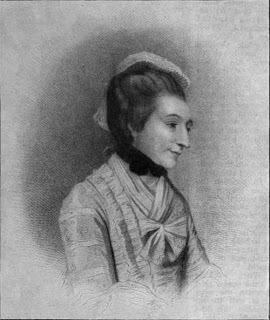 Mrs. Elizabeth Montagu
Mrs. Elizabeth MontaguFrom The Days Before Yesterday by Lord Frederic Hamilton (1856)
"The story of Mrs. Montagu is well known. The large house standing in a garden at the corner of Portman Square and Gloucester Place was built for Mrs. Montagu by James Wyatt at the end of the eighteenth century, and the adjoining Montague Street and Montagu Square derive their names from her. Somehow Mrs. Montagu's only son got kidnapped, and all attempts to recover the child failed. Time went on, and he was regarded as dead. On a certain 1st of May the sweeps arrived to clean Mrs. Montagu's chimneys, and a climbing-boy was sent up to his horrible task. . . he lost his way in the network of flues and emerged in a different room to the one he had started from. Something in the aspect of the room struck a half-familiar, half-forgotten chord in his brain. He turned the handle of the door to the next room and found a lady seated there. Then he remembered. Filthy and soot-stained as he was, the little sweep flung himself into the arms of the beautiful lady with a cry of "Mother!" Mrs. Montagu had found her lost son.
"In gratitude for the recovery of her son, Mrs. Montagu entertained every climbing-boy in London at dinner on the anniversary of her son's return and arranged that they should have a holiday on that day. At her death she left a legacy to continue the treat. Such, at least, is the story as I have always heard it."
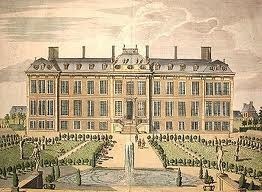 Montagu House
Montagu HouseEdwin Beresford Chancellor must have heard almost the same tale, for he writes in The History of the Squares of London: Topographical and Historical -
"Mrs. Montagu was one whose amiable character was almost better pleased in making happy those who were not invariably happy; and the feast to the chimney sweeps which she annually, on the 1st May, gave in the grounds of Montagu House, is an xemplification of this pleasant characteristic. That the sweeps — at that time, if not a dirtier, chimney-sweeping was a very much more terrifying, and often dangerous calling to its younger members — might enjoy one day of pure happiness in the year, she regaled them with beef and plum-pudding and gave them the run of her fine garden at Montagu House. There is a tradition that the origin of the idea was the kidnapping of a young Montagu — some say the son of Lady Mary Wortley — by chimney sweeps and his accidental return to his family, by a sweep employed to clean the chimneys of the house from which the child had many years before been stolen. If this be correct, the fraternity, had it been composed of logical minds, might well have deduced from such a return for such an act, almost an incentive to fresh depredations on the youthful offspring of their patrons."
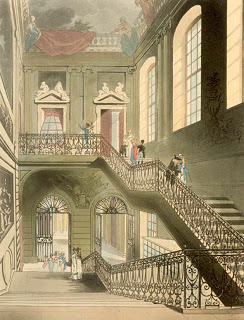 The staircase at Montagu House
The staircase at Montagu HouseBeresford's take on the story is closer to the truth in the tale - if any truth there be - since Elizabeth's own son, John, born in 1743, died suddenly when he was about a year old and therefore could not have been later either lost or kidnapped. She had no other children. A leader of English society, Elizabeth Robinson was born at York on the 2nd of October 1720. In 1742 she married Charles Montagu, cousin of Edward Wortley Montagu and son of the Earl of Sandwich -- a wealthy man, considerably her senior. Thanks to her, his Mayfair house became the social center of intellectual society in London, and her breakfast parties and evening conversationes gained for her from her admirers the title of "The Madame du Deffand of the English capital." When her husband died in 1775, Mrs. Montagu inherited a considerable fortune and large estates, in the management of which she proved shrewd. In 1781 she built Sandleford Priory, near Newbury. Elizabeth Montagu died on the 25th of August 1800.
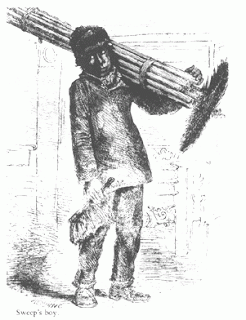
Published on May 01, 2011 02:01
April 30, 2011
The Royal Wedding in Milwaukee
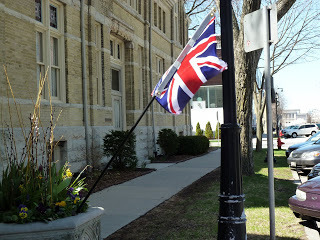 Kilbourn Avenue in Milwaukee, Wisconsin, on the shore of Lake Michigan, became a little slice of Britain on Friday, April 29, 2011. Members of the Woman's Club of Wisconsin, est. 1876, gathered at the elegant clubhouse to celebrate the wedding of Prince William and Catherine Middleton, now the Duke and Duchess of Cambridge.
Kilbourn Avenue in Milwaukee, Wisconsin, on the shore of Lake Michigan, became a little slice of Britain on Friday, April 29, 2011. Members of the Woman's Club of Wisconsin, est. 1876, gathered at the elegant clubhouse to celebrate the wedding of Prince William and Catherine Middleton, now the Duke and Duchess of Cambridge.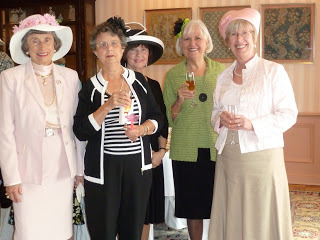 Kir Royales were approriate for the many toasts to the happy couple . . .
Kir Royales were approriate for the many toasts to the happy couple . . . 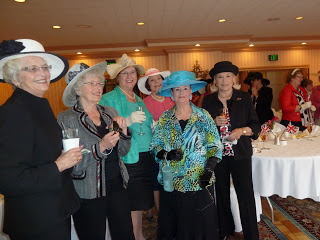 Everyone is always eager for an excuse to wear her favorite hat -- though some opted for fascinators.
Everyone is always eager for an excuse to wear her favorite hat -- though some opted for fascinators.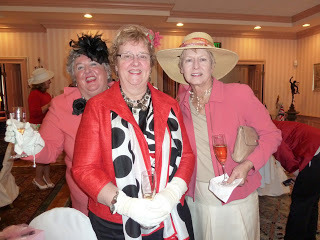
The printed Menu Card was cleverly contrived to include a picture of "The Kiss" aobve the words "William and Kate Forever." Thanks to the clever staff members who managed the feat!
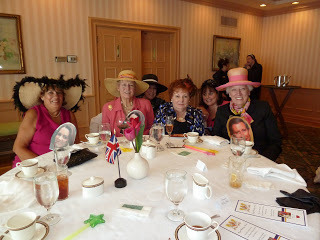 The menu, crafted by chef Steve Derby:Petite Pruime Rib of BeefQueen Elizabeth Mashed PotatoesMinted Pea PureeRoyal Bread Puddingwith Vanilla Sauce
The menu, crafted by chef Steve Derby:Petite Pruime Rib of BeefQueen Elizabeth Mashed PotatoesMinted Pea PureeRoyal Bread Puddingwith Vanilla Sauce
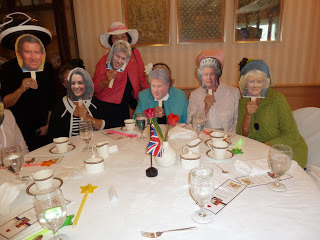 Some of the guests looked amazingly familiar...
Some of the guests looked amazingly familiar...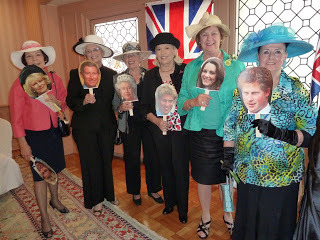 Oh, now we get it...And if Prince Harry is looking for some company, just send him over!
Oh, now we get it...And if Prince Harry is looking for some company, just send him over!We had a great time, just one of thousands of groups of Anglophiles the world over.Best wishes to the happy couple....
Published on April 30, 2011 02:00
April 28, 2011
The Wedding Day!
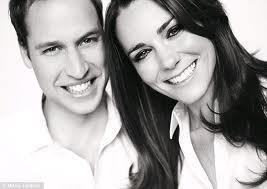
No post today - instead here's a spot for us to all chime in on the Royal Wedding as it unfolds. Stop back often and leave your comments during the ceremony and events that follow.
I'll leave the first comment - Finally!
Published on April 28, 2011 23:46
Wedding Central
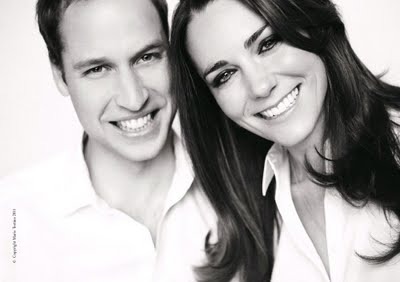
This page will be constantly updated - stop back often throughout the day
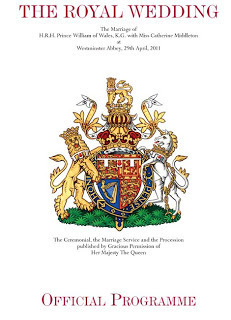
Look inside
 The Ceremony - minute by minute
The Ceremony - minute by minute 
The full guest list
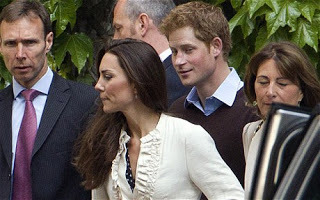
Today's last minute rehearsals in pictures and


Link to live updates
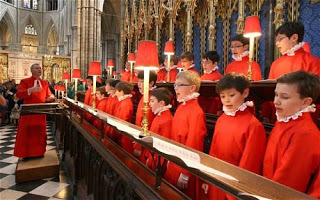
Listen to the wedding music
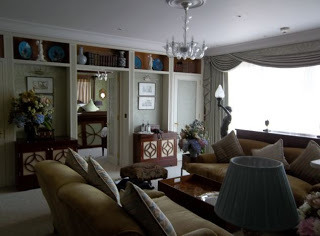
A peek inside Kate's suite at The Goring
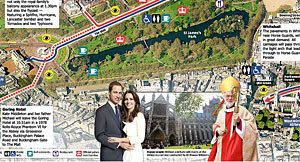
An essential guide to the RW

Wedding details and trivia

Chelsy Davy to wear TWO Ferretti's

Ellie Goulding to perform at reception

Details about the Royal after party at the Palace
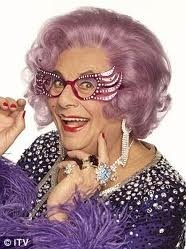
Dame Edna gives Piers Morgan some Royal insights
Published on April 28, 2011 06:41
Curiosity Corner

Who is it?
The first person to correctly identify the sitter will win this poster of Elizabeth Farren by Sir Thomas Lawrence from the Regency Power and Brilliance exhibition at the National Portrait Gallery in London.

Poster measures 20.5" x 30" or 510mm x 765mm
Please place your guess by using the "comments" link below this post.
Please Note : If you're our winner, and you're also a follower, there's a second prize in store for you. Register now by using the link in the right sidebar under "Those Who Call Number One London Home."
Good Luck!
Published on April 28, 2011 00:28
Kristine Hughes's Blog
- Kristine Hughes's profile
- 6 followers
Kristine Hughes isn't a Goodreads Author
(yet),
but they
do have a blog,
so here are some recent posts imported from
their feed.



